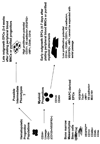Biologic properties of endothelial progenitor cells and their potential for cell therapy
- PMID: 17498522
- PMCID: PMC1978244
- DOI: 10.1016/j.pcad.2007.02.004
Biologic properties of endothelial progenitor cells and their potential for cell therapy
Abstract
Recent studies indicate that portions of ischemic and tumor neovasculature are derived by neovasculogenesis, whereby bone marrow (BM)-derived circulating endothelial progenitor cells (EPCs) home to sites of regenerative or malignant growth and contribute to blood vessel formation. Recent data from animal models suggest that a variety of cell types, including unfractionated BM mononuclear cells and those obtained by ex vivo expansion of human peripheral blood or enriched progenitors, can function as EPCs to promote tissue vasculogenesis, regeneration, and repair when introduced in vivo. The promising preclinical results have led to several human clinical trials using BM as a potential source of EPCs in cardiac repair as well as ongoing basic research on using EPCs in tissue engineering or as cell therapy to target tumor growth.
Figures

References
-
- Asahara T, Murohara T, Sullivan A, Silver M, Van der Zee R, Li T, Witzenbichler B, Schatteman G, Isner JM. Isolation of putative progenitor endothelial cells for angiogenesis. Science. 1997;275:964–967. - PubMed
-
- Risau W, Flamme I. Vasculogenesis. Annu Rev Cell Dev Biol. 1995;11:73–91. - PubMed
-
- Crosby JR, Kaminski WE, Schatteman G, Martin PJ, Raines EW, Siefert RA, Bowen-Pope DF. Endothelial cells of hematopoietic origin make a significant contribution to adult blood vessel formation. Circ Res. 2000;87:728–735. - PubMed
-
- Raffi S, Lyden D. Therapeutic stem and progenitor cell transplantation for organ vascularization and regeneration. Nature Med. 2003;9:702–712. - PubMed
Publication types
MeSH terms
Grants and funding
LinkOut - more resources
Full Text Sources
Other Literature Sources
Medical

